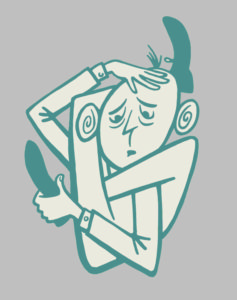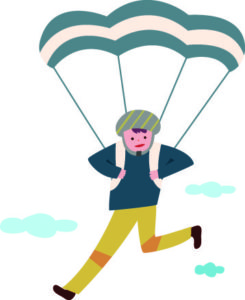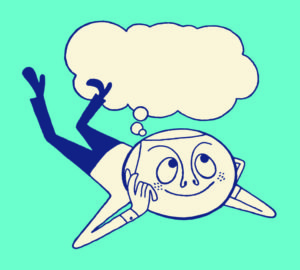Boredom is an epidemic and everyone is catching it: kids in classrooms, commuters on trains, mums at the park, and executives in glass offices. Many of us are deathly afraid of boredom. We distract ourselves from touching it by fiendishly focusing on our trusty smartphones. But research on the brain suggests we shouldn’t shun boredom outright. To paraphrase my pal Nietzsche, boredom won’t kill us and may even make us stronger.

When was the last time you felt bored? Boredom is the feeling of being trapped in an experience or unable to escape an undesirable moment. It’s the simultaneous feelings of restlessness, a lack of challenge, a lack of purpose¹. Sounds familiar? Mihaly Csikszentmihalyi (author of “FLOW”) believes boredom is the opposite of “flow state,” or full engagement of the brain. More precisely, boredom arises when one’s skills exceed current demand².
Inside our brains, boredom could, in fact, be dangerous. Chronic boredom can lead people into destructive behaviors like compulsive gambling, drug & alcohol addiction, and eating disorders. Easily bored people are more likely to be anxious, depressed, and hostile³. A brain on boredom has lower neural activity signaled by less oxygen and blood flow. Extended episodes of unwanted boredom may lead to loss of neuron shrinkage, atrophy, and even dementia4.
Of course not all boredom is the same. There are plenty of people working and students learning in repetitive, limited, under-stimulating scenarios5. Their boredom has to do with their environment and may not be directly within their control. We’ll save that for another article. The type of boredom addressed here is different; it’s a state of mind that we are choosing. This kind of boredom—the French ennui—is worth exploring more deeply.
So what’s the point of boredom? Why would evolution create this emotion if it were risky to our brains and mental health? Actually, boredom is a signal. It occurs when our emotional arousal declines1, telling our brains and bodies “Hey! It’s time for the next thing.”
Imagine a woman is jumping out of an airplane. At first she is petrified, terror ripples through her, she can barely breathe. As sensations of fear wash over her, these feelings gradually fade. She realizes this experience of falling is novel and challenging. Her feelings change to excitement, exhilaration, and even joy. But now as she’s still falling, the feelings of happiness recede and she begins to notice the beauty of the sky, the land below. She’s curious about the colors and textures she’s never seen before. It’s wondrous; but as the novelty of seeing the world from above becomes “normal,” feelings of awe fade away. Just then, she pulls the cord — her parachute engages and she’s floating above it all.
In the skydiving example, the woman has a range of strong feelings. Each emotional state rises, peaks, then diminishes, and boredom inserts itself into the experience. It is boredom that initiates the woman’s attention to shift and she is able to encounter a new set of emotional experiences. In this story, the shifting happens automatically. It’s not an obvious “wow, I’m so bored. I’m stuck here falling out of the sky.” Rather it’s a subtle form of boredom that rises naturally, signaling the brain to shift. Boredom sends a message to the brain “Ok brain, we understand and have mastered this information, we’re good to go for the next challenge.” Boredom alerts the brain to pay attention to something new.
So perhaps we’ve been misunderstanding our relationship to boredom. We fear the empty space between ideas – we perceive it as a terrible sensation of being alone, an ominous quiet. But maybe it’s not something so bad?
Let’s challenge our assumptions. What happens if we shine our light full in the face of boredom? What would happen if we stopped frenetically avoiding it? Let’s get curious about boredom.
Public Radio’s WNYC sponsored a “Bored and Brilliant” campaign earlier this year6. They created a podcast and series of exercises to help people get off their phones and confront boredom. http://www.wnyc.org/series/bored-and-brilliant/ The challenge was accepted by thousands of people who wanted to go phone-free, disconnect, observe, and embrace boredom. What did they find? Not so surprising stuff — by filling up all the empty moments in our lives, we’ve been keeping ourselves from experiencing downtime.
Maybe our issues with boredom are based on a big misunderstanding. So many of us are working so hard to avoid boredom that we’re accidentally getting rid of an essential ingredient: Space.
The WNYC campaign helped people understand the difference between being bored and being still. In this stillness we allow time for daydreaming, rest, meditation, openness and it’s critical to healthy life. Neuroscientist Mary Helen Immordino-Yang at USC did some fascinating work indicating that our lifestyle choices of media overstimulation (running away from boredom) limits our brain’s ability to access “default mode (DM)”. The brain’s DM is responsible for recalling personal memories, imagining the future, and feeling social emotions with moral connotations.7, 8
Your brain is amazing. Everyday you take it on a wild ride of emotional experiences and it keeps on going. Let’s understand and curiously appreciate boredom as a tool to help us live more fully. Boredom is the trough between breaking waves of emotions, and in that space, boredom gives us a nudge to seek new goals. Boredom signals us that it is time for change.
“Boredom is the trough between breaking waves of emotions.”
Yes, sometimes you are bored. So feel it. Don’t grab your phone and block the feeling. Instead, recognize the signal boredom is sending you. Make a change, find the next challenge for yourself and then repeat again and again…until it gets boring. •••
Here’s the “Bored And Brilliant” 6-Day Challenge from the series.
Day 1: Keep Your Phone in Your Pocket
Keep your phone in your bag when you are in motion. By not carrying your phone, you ease your sense that part of your attention must be on your phone. It will also open up some time to daydream. To learn more, read The Distraction Addiction, by Alex Soojung-Kim Pang (little, Brown and Company, 2013).
Day 2: Photo-Free Day
See the world through your eyes—not your screen. Don’t take any photo! By outsourcing your memories to your camera, your brain doesn’t bother storing the information. A study done at Fairfield University in Connecticut showed that taking a photo in an art museum impacts your ability to remember what you see. (L.A. Henkel, “Point-and-shoot Memories: The Influence of Taking Photos on Memory for a Museum Tour,” Psychological Science, Dec. 2013
Day 3: Delete That App
We all have that one app that we spend too much time on. Find the app that is wasting your time… And then delete it. For more information about how these games can be addicting, check out Hooked: How to Build Habit-Forming Products by Nir Eyal (2013).
Day 4: Take a Fauxcation
Disconnect from the digital world for a day. Set an out-of-office message as if you were on vacation. Set an “away” message on instant messaging and social media. Disconnect at work and take some time to just think.
Day 5: One Small Observation
Go somewhere public, anywhere, and hang out. Observe the world around you and let your mind wander. Just notice some- thing—anything. This is the type of situation in which humans are most creative and imaginative.
Day 6: Dream House
Put your phone away. Get bored (by watching a generous pot of water come to a boil or writing 0s and 1s on a small piece of paper in small font). Then, empty the contents of your wallet onto the table and use the items to create your dream house. Give the house a name, take a photo, and then send it in.
Box Excerpt from Ebling, Maria R. “The Importance of Being… Bored.” IEEE Pervasive Computing 2 (2015): 5-8.
MOVIE LINK From WNYC
Check out this on the street reporting–How Many People can’t walk without their cell phones? https://www.youtube.com/watch?v=pxlIE7fc-Vs
CITATIONS
1. Bench, Shane W., and Heather C. Lench. “On the function of boredom.” Behavioral Sciences 3.3 (2013): 459-472.
2. Csikszentmihalyi, Mihaly, and Mihaly Csikzentmihaly. Flow: The psychology of optimal experience. Vol. 41. New York: HarperPerennial, 1991.
3. Gosline, Anna. “Bored to Death: Chronically Bored People Exhibit Higher Risk-Taking Behavior.” Scientific American (2007).
4. Saunders, M. N. “The physiology of boredom, depression and senile dementia.” Medical hypotheses 46.5 (1996): 463-466.)
5. Willis, Judy. “Neuroscience Reveals That Boredom Hurts: Students Who Seem to Willfully Defy Admonishments to Focus on Their Work May Not Be Doing So Intentionally but Rather as a Normal, Age-Appropriate Brain Reaction.” Phi Delta Kappan 95.8 (2014): 28.
6. Zomorodi, Manoush. “Bored and Brilliant.” Note To Self Blog. WNYC, 7 Feb. 2015. Web. 5 Aug. 2015.
7. Jabr, Ferris. “Why your brain needs more downtime.” Scientificamerican.com (2013).
8. Immordino-Yang, Mary Helen, Joanna A. Christodoulou, and Vanessa Singh. “Rest is not idleness implications of the brain’s default mode for human development and education.” Perspectives on Psychological Science 7.4 (2012): 352-364.
9. Ebling, Maria R. “The Importance of Being… Bored.” IEEE Pervasive Computing 2 (2015): 5-8.
- Four Tips to Make A Culture of Learning from Mistakes: EQ Educator News - April 10, 2024
- Emotional Intelligence to Reduce Teacher Burnout: EQ Education News - March 13, 2024
- Elmo Said WHAT? Research & Tips for Emotions for Wellbeing – EQ Education - February 6, 2024




As someone that believes in the power of quiet space I am at times completely bound to my cell phone. There have been times when I would leave my phone somewhere and be unable to do anything else until I recovered it. Recently, I left my phone at home and resolved to spend the day without it. I actually felt lighter and was able to manage my day to day responsibilities. Having the space to just think was refreshing.
Having lived and worked in the Silicon Valley for the past 20 years, I find it to be a place of consumption, particularly when it comes to information, communication, and media. It’s as if the norm is to consume more than the next person so that you can stay ahead of the pack. I often find myself trying to “catch up” with those who are at the cusp of the next best thing.
The challenge for me is the slow down and embrace those moments of pause, check in with myself, and feel the emotions, people, and happenings around me. I’m reminded of a time when my wife and I stopped ourselves and asked whether we were enjoying the time with our newborn or if we were just trying to get by. That, and many other reminders, has challenged us to use those pauses in life to check in and reevaluate. I’m looking forward to being more conscious of those moments.
Thinking of boredom as a signal means we have to stop and reflect and consider what is the cause, and what are the options for moving on to something different? If we don’t pause and reflect rather than filling the space, we miss a valuable, free opportunity to sit with the dissonance and consider what we would most like to fill the space. If we could use boredom in that way, maybe we would be more intentional in our movement and even cut out some of the “space filling,” time-consuming stuff that really doesn’t matter to us in the long run.
Yes!! Do not try to escape or deflect boredom with TV, YouTube, Twitter, Facebook and such. All of these are someone else’s creativity. Find your own creativity. Get bored until you can’t stand it anymore and see what happens. And something will happen as long as you trust yourself and your mind’s ability to lead you the right way.
I get bored, oh how I get bored. I push the go button often and early. I do not stop ever ever ever.
i have practiced the things that Patty has written to great effect on my own journey.
It has helped in ways that were unexpected. Here is what I mean, I have come to the conclusion for me that boredom might truly be mindfullness and I really need to lean into the feeling and not judge myself in the process.
Yes I get bored but learning to be mindful
Anything artistic is a movement in the right direction. Sometimes one needs to abandon their preferences and just be in the moment, neither past nor future, and just be open to being moved by the art and the artist. That can happen with painting, performances, poetry, music and many other ways people express themselves. One can choose to be in the audience or take the role of creator, sharing their expressions and gifts, for humanity’s sake. And along the way, we can experience a little evolution, a bit of improvement in our lives. (and by the way, art can be found on phones – it’s just a matter of choosing what to do and look at).